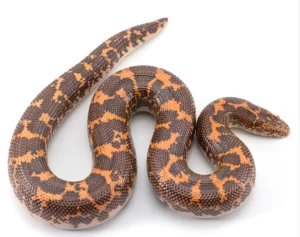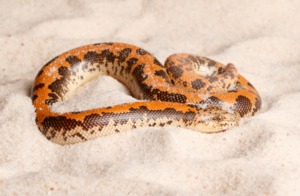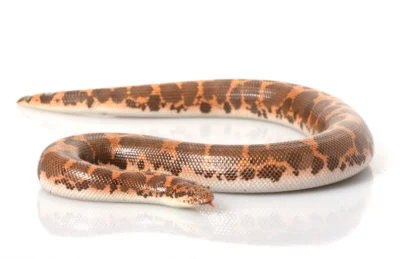Sand boas are known for their burrowing nature, often found in sandy habitats across different continents. Their diet reflects their environment and evolutionary history, offering us a glimpse into their survival strategies and natural behaviors. So, let’s unravel the mystery of what do sand boas eat on in their sandy homes.
Sand boas are primarily carnivorous, meaning they primarily eat other animals. In the wild, their diet typically consists of small rodents, such as mice, rats, and occasionally birds and lizards. They are ambush predators, lying in wait for their prey to come within striking distance before seizing it with their sharp teeth and constricting their coils around it.
In captivity, sand boas are commonly fed appropriately sized mice or rats, depending on the size and age of the snake. Some keepers also offer chicks or quails as part of their diet. It’s essential to ensure that the prey items are of appropriate size and nutritional content to meet the nutritional needs of the sand boa.
How sand boas diet impacts their growth and health

The diet of sand boas plays a crucial role in their growth and overall health. Here’s how:
- Nutritional Balance: A well-balanced diet provides essential nutrients such as proteins, fats, vitamins, and minerals necessary for growth, development, and overall health. Insufficient or imbalanced nutrition can lead to stunted growth, developmental issues, and a weakened immune system.
- Size and Weight: Proper feeding ensures that sand boas reach their optimal size and weight for their age and species. Overfeeding can lead to obesity, which may cause health problems such as fatty liver disease and cardiovascular issues. Conversely, underfeeding can result in slow growth and developmental delays.
- Bone Health: Calcium and vitamin D3 are crucial for maintaining strong bones and preventing metabolic bone diseases like osteoporosis. Sand boas require a diet with adequate calcium to phosphorus ratio to support bone health and prevent deformities or fractures.
- Reproduction: Proper nutrition is essential for reproductive health in sand boas. Females need to be in good nutritional condition to produce healthy eggs and successfully carry and birth offspring. Inadequate nutrition can lead to reproductive issues, including egg binding and low fertility rates.
- Immune Function: A nutritious diet strengthens the immune system, helping sand boas resist diseases and infections. Malnutrition weakens the immune response, making snakes more susceptible to illnesses and parasites.
- Behavior and Activity Levels: Sand boas’ activity levels and behavior can be influenced by their diet. A well-fed snake is more likely to exhibit natural behaviors, such as hunting and exploration, while a snake with an inadequate diet may become lethargic or inactive.
Overall, providing a varied and nutritionally balanced diet tailored to the specific needs of sand boas is essential for promoting their growth, maintaining their health, and ensuring their overall well-being in captivity. Regular monitoring of their weight, body condition, and feeding behavior can help snake keepers adjust their diet as needed to support optimal growth and health.
What Do Sand Boas Eat?
Sand boas are carnivorous snakes, meaning they primarily eat other animals. In their natural habitat, which often includes sandy regions across various continents, their diet typically consists of small rodents like mice and rats. However, they are opportunistic feeders and may also consume other small vertebrates such as birds and lizards when available.
Sand boas are ambush predators, relying on stealth and patience to catch their prey. They often bury themselves in sand or lie in wait under cover, waiting for an unsuspecting animal to pass by. When prey is within striking distance, sand boas use their excellent sense of smell and specialized heat-sensing organs to detect and track it. They then strike with precision, seizing the prey in their jaws and wrapping their bodies around it to constrict and suffocate it.
In captivity, sand boas are commonly fed appropriately sized rodents, usually mice or rats. The size of the prey offered depends on the size and age of the snake. Some keepers also offer other small vertebrates like chicks or quails to provide dietary variety.
A proper diet is essential for the health and well-being of sand boas, both in the wild and in captivity. It provides them with the energy and nutrients needed for growth, reproduction, and overall vitality. Offering a varied diet that mimics their natural prey items helps ensure that they receive a balanced nutritional intake.
Types of Prey Consumed by Sand Boas
Sand boas are versatile predators that primarily consume small vertebrates, particularly rodents, in their natural habitat. However, their diet can vary based on factors such as availability and habitat. Here are some types of prey commonly consumed by sand boas:
- Mice: In the wild, mice are a staple food source for many sand boa species. These small rodents are abundant in various habitats and provide a readily available source of nutrition.
- Rats: Larger species of sand boas may prey on rats, which offer more substantial meals. Rats are also common in many of the same habitats where sand boas are found.
- Birds: Sand boas are known to consume small birds when the opportunity arises. They may ambush birds as they forage on the ground or roost in low vegetation.
- Lizards: Some sand boa species, particularly those inhabiting areas with a high lizard population, may feed on small lizards. These reptiles offer a diverse nutritional profile and are an important food source for sand boas in certain regions.
- Amphibians: In wetland habitats where amphibians are abundant, sand boas may include frogs or toads in their diet. These prey items offer a different texture and nutritional content compared to rodents.
- Insects: While not a primary food source, sand boas may occasionally consume insects such as beetles or grasshoppers, especially juveniles exploring their environment and experimenting with different prey types.
Overall, sand boas are opportunistic feeders capable of adapting their diet to the prey available in their environment. Their diverse range of prey items reflects their ability to thrive in various habitats across different continents.
Also, in captivity, offering a varied diet that includes rodents supplemented with occasional alternative prey items helps ensure the nutritional health of pet sand boas.
Hunting and Feeding Behavior of Sand Boas
Sand boas exhibit fascinating hunting and feeding behaviors that are well adapted to their burrowing lifestyle and ambush predator strategy.
- Ambush Predation: Sand boas are ambush predators, meaning they rely on stealth and patience to catch their prey. They often bury themselves in sand or lie concealed under debris, waiting for unsuspecting prey to pass by. This strategy allows them to conserve energy while maximizing their chances of catching prey.
- Sensory Perception: Sand boas have highly developed sensory organs, including specialized heat-sensing pits located on their face. These pits enable them to detect the infrared radiation emitted by warm-blooded prey, even in complete darkness. Additionally, they possess a keen sense of smell, which helps them locate prey in their sandy habitats.
- Striking and Constriction: When prey comes within striking distance, sand boas lunge forward with remarkable speed and accuracy, seizing the prey in their jaws. They then use their muscular bodies to coil around the prey and apply constriction pressure. This suffocates the prey and prevents it from escaping.
- Swallowing Prey Whole: Sand boas are capable of swallowing prey much larger than their own heads, thanks to their highly flexible jaws and expandable throat muscles. They consume their prey whole, relying on powerful peristaltic contractions to move the prey down their digestive tract.
- Burrowing Behavior: After feeding, sand boas may retreat to their burrows or other underground shelters to digest their meal in safety. Burrowing allows them to avoid predators and environmental disturbances while they metabolize their food.
- Feeding Frequency: Sand boas do not require frequent feeding compared to some other snake species. Their relatively slow metabolism allows them to go for extended periods between meals. In captivity, adult sand boas may be fed every 1-2 weeks, while juveniles may require more frequent feedings.
Understanding the hunting and feeding behaviors of sand boas is essential for providing proper care in captivity. Offering appropriately sized prey items and replicating their natural feeding environment helps ensure their health and well-being.
Additionally, providing opportunities for natural behaviors, such as burrowing and hunting, enriches the captive environment for these fascinating snakes.
Common Feeding Problems and Solutions

Feeding problems can occasionally arise when caring for sand boas in captivity. Here are some common issues and potential solutions:
- Refusal to Eat: Sometimes sand boas may refuse to eat, especially during periods of stress, illness, or environmental changes. If your sand boa refuses food for an extended period, it’s essential to rule out any underlying health issues first. Once health concerns are addressed, you can try the following solutions:
- Ensure the enclosure’s temperature and humidity levels are within the appropriate range for sand boas.
- Try offering different types of prey items or presenting them in different ways (e.g., scented or live prey).
- Reduce handling and other sources of stress to help your snake feel more comfortable and secure.
- Regurgitation: Regurgitation occurs when a sand boa brings back up partially or fully digested prey. This can happen due to several reasons, including improper handling, feeding prey that is too large, or feeding too soon after a meal. To prevent regurgitation:
- Avoid handling your sand boa for at least 24-48 hours after feeding.
- Ensure prey items are appropriately sized (no larger than the widest part of the snake’s body).
- Allow sufficient time for digestion between feedings (typically 3-5 days for juveniles and 7-10 days for adults).
- Obesity: Overfeeding can lead to obesity in sand boas, which can have serious health consequences, including fatty liver disease and reduced lifespan. To prevent obesity:
- Offer appropriately sized prey items relative to the snake’s size and age.
- Follow a feeding schedule based on the snake’s age and metabolic rate.
- Monitor your sand boa’s body condition regularly and adjust feeding frequency as needed.
- Poor Nutrition: Feeding a diet that lacks variety or is nutritionally imbalanced can result in deficiencies and health issues over time. To ensure optimal nutrition:
- Offer a varied diet that includes a mix of different prey items (e.g., mice, rats, chicks) to provide a diverse range of nutrients.
- Consider supplementing prey items with calcium and vitamin D3 for bone health.
- Consult with a reptile veterinarian or experienced breeder for guidance on providing a balanced diet.
- Aggression during Feeding: Some sand boas may exhibit aggressive behavior during feeding, striking at the handler’s hand instead of the prey item. To prevent injury:
- Use feeding tongs or tweezers to offer prey items instead of hand-feeding.
- Maintain a safe distance from the snake’s strike range while offering food to avoid accidental bites.
By addressing common feeding problems and implementing appropriate solutions, you can help ensure the health and well-being of your sand boa in captivity. Regular observation and adjustments to feeding practices based on your snake’s behavior and condition are essential for their long-term care.
Tips on Feeding Sand Boas
Feeding sand boas can be a straightforward process with the right approach. Here are some tips to help ensure successful feeding:
- Choose Appropriate Prey Size: Offer prey items that are appropriately sized for your sand boa’s age and size. The prey should be no wider than the widest part of the snake’s body to prevent choking or regurgitation.
- Variety in Diet: Provide a varied diet to ensure nutritional balance. Offer a mix of prey items such as mice, rats, chicks, and quails. This helps mimic the diversity of prey they would encounter in the wild and provides a range of nutrients.
- Prey Presentation: Experiment with different ways of presenting prey to entice your sand boa to feed. Some snakes prefer live prey, while others may accept pre-killed or thawed frozen prey. You can also try wiggling or scenting prey to stimulate hunting behavior.
- Feeding Schedule: Establish a feeding schedule based on your sand boa’s age and size. Juveniles may require more frequent feedings (every 5-7 days), while adults can be fed less often (every 7-14 days). Adjust feeding frequency as needed based on your snake’s growth and activity level.
- Feeding Enclosure: Use a separate feeding enclosure or feeding container to minimize stress and prevent substrate ingestion during feeding. This also helps associate the feeding area with food, reducing the risk of accidental strikes outside of feeding time.
- Temperature and Environment: Ensure the enclosure’s temperature and humidity levels are appropriate for sand boas. Optimal temperatures stimulate digestion and encourage feeding behavior. Provide a warm spot (around 85-90°F or 29-32°C) where your sand boa can digest its meal comfortably.
- Avoid Disturbances: Minimize disturbances during and after feeding to prevent stress and regurgitation. Avoid handling your sand boa for at least 24-48 hours after feeding to allow for proper digestion.
- Monitor Behavior: Pay attention to your sand boa’s feeding behavior and body condition. If your snake consistently refuses food or shows signs of health issues, consult with a reptile veterinarian for advice and evaluation.
By following these tips and observing your sand boa’s preferences and behavior, you can establish a feeding routine that supports their health and well-being in captivity. Remember to be patient and consistent, as individual snakes may have unique feeding habits and preferences.
Conclusion
This page answers the question on what do sand boas eat. Sand boas are carnivorous snakes known for their preference for small rodents like mice and rats, though they may also consume other small vertebrates such as birds and lizards.
Their diet reflects their role as ambush predators, adapted to sandy habitats across various continents. In captivity, providing appropriately sized rodents and occasionally supplementing their diet with alternative prey items ensures their nutritional needs are met. Understanding what do sand boas eat is fundamental to their care, supporting their health and vitality in captivity.

